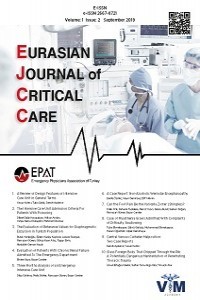Evaluation of infants undergoing cranial computed tomography in the emergency department due to head trauma
Evaluation of infants undergoing cranial computed tomography in the emergency department due to head trauma
head trauma, infant, computed tomography, emergency department,
___
- Bowman SM, Bird TM, Aitken ME, Tilford JM. Trends in hospitalizations associated with pediatric traumatic brain injuries. Pediatrics 2008;122:988-93.
- Tabish A, Lone NA, Afzal WM, Salam A. The incidence and severity of injury in children hospitalised for traumatic brain injury in Kashmir. Injury 2006;37:410-5.
- Dietrich AM, Bowman MJ, Ginn-Pease ME, Kosnik E, King DR. Pediatric head injuries: can clinical factors reliably predict an abnormality on computed tomography? Ann Emerg Med 1993; 22: 1535-40.
- Qauyle KS, Jaffe DM, Kuppermann N, Kaufman BA, Lee BC, Park TS, et al. Diagnostic testing for acute head injury in children: when are head computed tomography and skull radiographics indicated? Pediatrics.1997; 99: e11.
- Tintinalli J, Kelen GD, Stapczynski JS. Emergency Medicine, Comprehensive Study Guide. American Collage of Physicians. The McGraw-Hill Companies, Inc. Sixth edition, section 22, Pediatric trauma, P: 1545-6.
- Langlois JA, Rutland-Brown W, Thomas KE. Traumatic brain injury in the United States. Atlanta, GA: Centers for Disease Control and Prevention; 2006
- Beaudin M, Saint-Vil D, Ouimet A, Mercier C, Crevier L. Clinical algorithm and resource use in the management of children with minor head trauma. J Pediatr Surg 2007; 42: 849-52.
- Savitsky EA, Votey SR. Current controversies in the management of minor pediatric head injuries. Am J Emerg Med 2000; 18: 96-101.
- Langlois JA, Rutland-Brown W, Wald MM. The epidemiology and impact of traumatic brain injury: a brief overview. J Head Trauma Rehabil 2006;21:375-8.
- Ragnarsson KT. Traumatic brain injury research since the 1998 NIH Consensus Conference: accomplishments and unmet goals. J Head Trauma Rehabil 2006;21:379-87.
- Centers for Disease Control and Prevention (CDC). Statespecific prevalence of cigarette smoking among adults and quitting among persons aged 18-35 years--United States, 2006. MMWR Morb Mortal Wkly Rep 2007;56(38):993-6.
- Shane SA, Fuchs SM. Skull fractures in infants and predictors of associated intracranial injury. Pediatr Emerg Care 1997; 13: 198-203.
- Greenes DS, Schutzman SA. Clinical significance of scalp abnormalities in asymptomatic head-injured infants. Pediatr Emerg Care 2001; 17: 88-92.
- Brenner D, Elliston C, Hall E, Berdon W. Estimated risk of radiationinduced fatal cancer from pediatric CT. AJR Am J Roentgenol 2001; 176: 289-96.
- Brenner DJ. Estimating cancer risks from pediatric CT: going from the qualitative to the quantitative. Pediatric Radiol 2002; 32: 228-31. [CrossRef]
- Köksal Ö, Özeren G, Yenice H, Çildir E. Is Cranial Computerized Tomography Really Necessary for Infants With Minor Head Trauma? JAEM 2011: 56-9
- Türedi S, Hasanbasoğlu A, Gündüz A, Yandı M. Clinical desicion instruments for CT scan in minor head trauma. J Emerg Med 2008; 34: 253-9.
- Başlangıç: 2019
- Yayıncı: Acil Tıp Uzmanları Derneği
Exposure to Infrared Light: Case Series
Ayla KÖKSAL, Cesareddin DİKMETAŞ, Büşra BİLDİK, Serkan DOĞAN, Dilek ATİK, Başar CANDER
Yahya Kemal GÜNAYDIN, Miraç ALTUN, Dilber ÜÇÖZ KOCAŞABAN
Periorbital Air Following Sneeze: Case Report
Yağmur Gökhan SEMERCİ, Cesareddin DİKMETAŞ, Ayla KÖKSAL, Dilek ATİK, Serkan DOĞAN, Duygu YAMAN, Başar CANDER
POST ERCP PERFORATION: A CASE REPORT
Hasan GÖKÇE, Muhammed EKMEKYAPAR, Şükrü GÜRBÜZ, Serdar DERYA
THE NEW BIOMARKERS USED IN THE DIFFERENTIATION BETWEEN TRANSUDATE AND EXUDATE PLEURAL EFFUSIONS
Dilek ATİK, Bengu SELİMAN, Derya BALCI KOROGLU, Bensu BULUT, Bahadır TASLIDERE
Bilateral Facial Paralysis Following Tooth Extraction: Case Report
Dilek ATİK, Cesareddin DİKMETAŞ, Ayla KÖKSAL, Serkan DOĞAN, Ahmet ERDUR, Basar CANDER
Does a potato threat your life? A Case Study
Serkan DOĞAN, Bensu BULUT, Ramiz YAZICI, Canan AKMAN, Zeynep SARAL ÖZTÜRK, Ekim SAĞLAM GÜRMEN, Tarık OCAK, Başar CANDER
A RARE TRAUMA COMPLICATION: PNEUMOPERICARDIUM
Ömür UYANIK, Muhammed EKMEKYAPAR, Hakan OĞUZTÜRK, Şükrü GÜRBÜZ, Ramazan AVCU
Ramazan ÜNAL, Dilek ATİK, Ahmet ERDUR, Bensu BULUT, Hasan ÇAM, Salih FETTAHOĞLU, Ramazan GÜVEN, Başar CANDER
